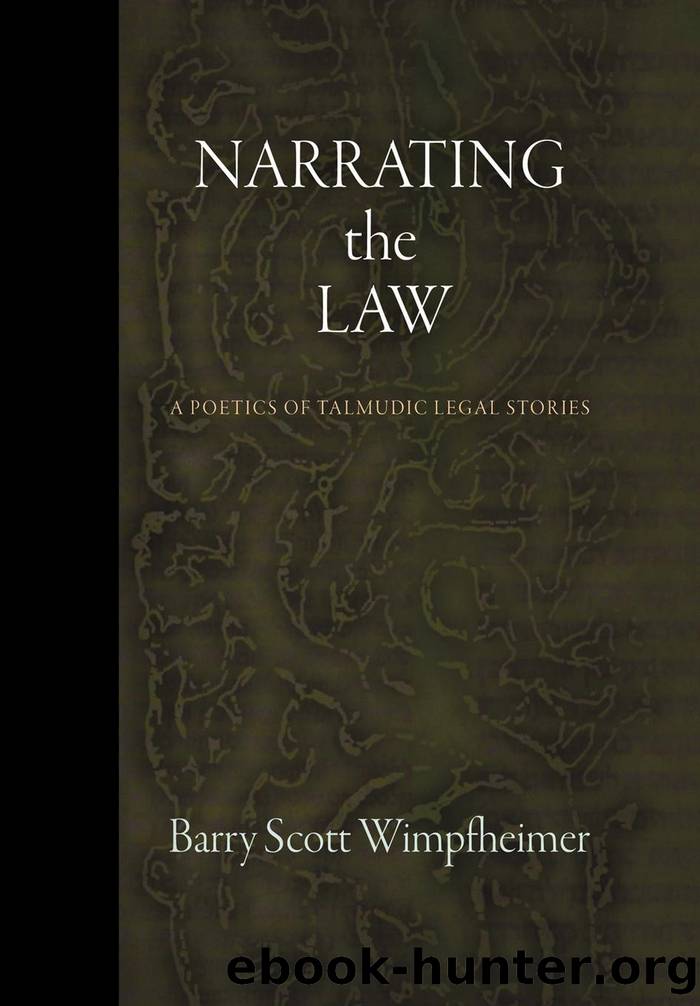Narrating the Law by Wimpfheimer Barry Scott;

Author:Wimpfheimer, Barry Scott;
Language: eng
Format: epub
Publisher: University of Pennsylvania Press
Published: 2019-08-15T00:00:00+00:00
Chapter 5
Torah as Cultural Capital: Rabbis and Rabbis
In his book The Rules of Art, Pierre Bourdieu models a method of literary analysis that employs his own socioeconomic framework of analyzing culture to read Flaubertâs novel Sentimental Education.1 The novel is structured around the life of Frédéric Moreau and several friends and set in nineteenth-century Paris. Many critics have understood Frédéric as a proxy for his creator, and literary analysis of Sentimental Education is dominated by historicist readings that map the novel onto Flaubertâs autobiography. The Rules of Art, by contrast, employs the novel as a window onto nineteenth-century Parisian sociology. The book opens with each of its central characters possessing disparate quantities of different forms of capital (political, financial, social), and each character is motivated by his or her construal of success as the assimilation of great quantities of one or more forms of capital. By using the charactersâ own constructions of these separate fields of capital, Bourdieu can evaluate each characterâs own sense of success. The novel thus enables an internal sociological analysis. The novel provides âall the tools necessary for its own sociological analysis: the structure of the book, which a strictly internal reading brings to light, that is, the structure of the social space in which the adventures of Frédéric unfold, proves to be at the same time the structure of the social space in which its author himself was situated.â2
Bourdieuâs literary approach offers an alternative historicism that allows the critic to plumb the novel for the social space it constructs, using the outcome of that probing to construct a sociology of the authorâs cultural context. Bourdieu claims that Sentimental Education possesses a prophetic awareness of sociological structure, an awareness veiled until the sociological critic unveils it.3 In Bourdieuâs understanding, the textual unconscious preserves sociological structures. The criticâs job is to uncover these structures through a strictly internal reading of the literature.
Bourdieuâs model of internal literary sociology is enticing for the study of Babylonian rabbinic sociology because in the case of Babylonian rabbinic Judaism the absence of significant data on the rabbis external to the Talmud makes internal sociology the only possible sociology. The following pages employ Bourdieuâs technique and theoretical insights in reading BÄbÄ BatrÄ 20bâ22a as a cryptogram that provides its own key, using these texts to describe the parallel fields of Torah and commerce. The results of this internal sociology are an awareness of the internal hierarchies of the rabbinic world and the struggle of individual rabbis to assert a personal authority over other Jews, even rabbinic ones.
Download
This site does not store any files on its server. We only index and link to content provided by other sites. Please contact the content providers to delete copyright contents if any and email us, we'll remove relevant links or contents immediately.
| Haggadah | Hasidism |
| History | Holidays |
| Jewish Life | Kabbalah & Mysticism |
| Law | Movements |
| Prayerbooks | Sacred Writings |
| Sermons | Theology |
| Women & Judaism |
Man's Search for Meaning by Viktor E. Frankl(2264)
The Secret Power of Speaking God's Word by Joyce Meyer(2259)
Mckeown, Greg - Essentialism: The Disciplined Pursuit of Less by Mckeown Greg(2117)
MOSES THE EGYPTIAN by Jan Assmann(1978)
Unbound by Arlene Stein(1945)
Devil, The by Almond Philip C(1907)
The Complete Dead Sea Scrolls in English (7th Edition) (Penguin Classics) by Geza Vermes(1846)
I Capture the Castle by Dodie Smith(1579)
Schindler's Ark by Thomas Keneally(1517)
The Invisible Wall by Harry Bernstein(1463)
The Gnostic Gospel of St. Thomas by Tau Malachi(1415)
The Bible Doesn't Say That by Dr. Joel M. Hoffman(1374)
The Secret Doctrine of the Kabbalah by Leonora Leet(1272)
The Jewish State by Theodor Herzl(1255)
The Book of Separation by Tova Mirvis(1227)
A History of the Jews by Max I. Dimont(1212)
The Dead Sea Scrolls Bible by Martin G. Abegg(1204)
Political Theology by Carl Schmitt(1189)
Oy!: The Ultimate Book of Jewish Jokes by David Minkoff(1107)
